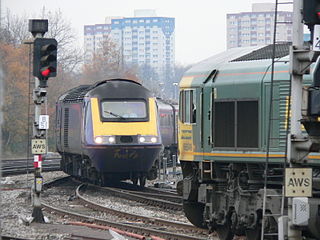
A railway signal is a visual display device that conveys instructions or provides warning of instructions regarding the driver's authority to proceed. The driver interprets the signal's indication and acts accordingly. Typically, a signal might inform the driver of the speed at which the train may safely proceed or it may instruct the driver to stop.

Railway signalling (BE), or railroad signaling (AE), is a system used to control the movement of railway traffic. Trains move on fixed rails, making them uniquely susceptible to collision. This susceptibility is exacerbated by the enormous weight and inertia of a train, which makes it difficult to quickly stop when encountering an obstacle. In the UK, the Regulation of Railways Act 1889 introduced a series of requirements on matters such as the implementation of interlocked block signalling and other safety measures as a direct result of the Armagh rail disaster in that year.

Automatic Warning System (AWS) is a railway safety system invented and predominantly used in the United Kingdom. It provides a train driver with an audible indication of whether the next signal they are approaching is clear or at caution. Depending on the upcoming signal state, the AWS will either produce a 'horn' sound, or a 'bell' sound. If the train driver fails to acknowledge a warning indication, an emergency brake application is initiated by the AWS. However if the driver correctly acknowledges the warning indication by pressing an acknowledgement button, then a visual 'sunflower' is displayed to the driver, as a reminder of the warning.

Cab signaling is a railway safety system that communicates track status and condition information to the cab, crew compartment or driver's compartment of a locomotive, railcar or multiple unit. The information is continually updated giving an easy to read display to the train driver or engine driver.
A wrong-side failure describes a failure condition in a piece of railway signalling equipment that results in an unsafe state. A typical example would be a signal showing a 'proceed' aspect when it should be showing a 'stop' or 'danger' aspect, resulting in a "false clear".

Linienzugbeeinflussung is a cab signalling and train protection system used on selected German and Austrian railway lines as well as on the AVE and some commuter rail lines in Spain. The system was mandatory where trains were allowed to exceed speeds of 160 km/h (99 mph) in Germany and 220 km/h (140 mph) in Spain. It is also used on some slower railway and urban rapid transit lines to increase capacity. The German Linienzugbeeinflussung translates to continuous train control, literally: linear train influencing. It is also called linienförmige Zugbeeinflussung.

The railway signalling system used across the majority of the United Kingdom rail network uses lineside signals to control the movement and speed of trains.
Australian railway signalling varies between the States of Australia, because the individual States are responsible for the railway systems within their own borders, with, historically, no need to co-ordinate between states except at the boundaries.

Transmission Voie-Machine is a form of in-cab signalling originally deployed in France and is mainly used on high-speed railway lines. TVM-300 was the first version, followed by TVM-430.
Railway signals in Germany are regulated by the Eisenbahn-Signalordnung. There are several signalling systems in use, including the traditional H/V (Hauptsignal/Vorsignal) system.
A train protection system is a railway technical installation to ensure safe operation in the event of human error.
The signalling system used on the standard-gauge railway network in Sweden is based on that of the traditional mechanical semaphore signals. Currently only colour-light signals are used, together with the Ansaldo L10000 Automatic Train Control system.

North American railroad signals generally fall into the category of multi-headed electrically lit units displaying speed-based or weak route signaling. Signals may be of the searchlight, color light, position light, or color position light types, each displaying a variety of aspects which inform the locomotive operator of track conditions so that they may keep their train under control and able to stop short of any obstruction or dangerous condition.

Railway semaphore signal is one of the earliest forms of fixed railway signals. This semaphore system involves signals that display their different indications to train drivers by changing the angle of inclination of a pivoted 'arm'. Semaphore signals were patented in the early 1840s by Joseph James Stevens, and soon became the most widely used form of mechanical signal. Designs have altered over the intervening years, and colour light signals have replaced semaphore signals in most countries, but in a few they remain in use.
Sistema di Controllo della Marcia del Treno (SCMT) is a discontinuous train cab signalling system used in Italy. It shares many features with the Ripetizione Segnali (RS) system, the two systems co-existing and working together. The main purpose of SCMT is to control the respect of the speed limit imposed by the signal aspect and the line condition.
The current French railway signalling system is in force on the Réseau Ferré de France since 1930, when the code Verlant was applied.

Japanese railway signals, according to the ministerial decree defining technical standards of railways, are defined as indicating operational conditions for railway staff driving trains.
Swiss railway signalling describes the railway signalling systems used in Switzerland by the different railway companies. There are two main types of signal, used up to 160 km/h, above which speed cab signalling is required.

The application of railway signals on a rail layout is determined by various factors, principally the location of points of potential conflict, as well as the speed and frequency of trains and the movements they require to make.
The Polish (PKP) railway signalling system provides a complex outlook of traffic situations, yet is quite easy to understand. Signals can be divided into following categories:



































